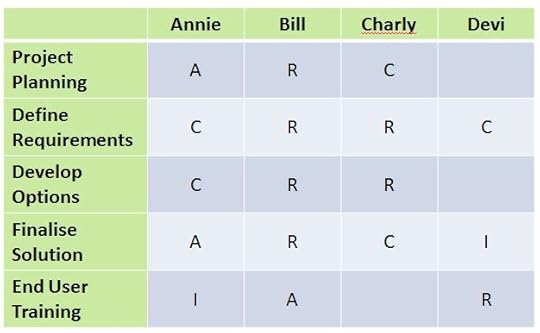The Roles and Responsibilities Document on Projects

Does your project team have a roles and responsibilities document that sets out what everyone does? I try to make sure all my projects have one. It's a really simple document that helps clarify how everyone is contributing to the project.
In this article we'll look at what it is and how you can use it, and I'll share some tips on how I use it to manage my projects.
 What is a Roles andResponsibilities document?
What is a Roles andResponsibilities document?Here's a definition:
A Roles and Responsibilities document is a formal way of defining what each role is responsible for on a project team.
Roles are not the same as people. One individual can hold more than one role. Some people on the project team may have more than one role.
For example, the project manager has a role involving leading the project, and also a role on the project board as someone responsible for project governance.
Responsibilities are the tasks that the role is responsible for carrying out. For example, the project sponsor is responsible for chairing the project board meetings.
Why do you need a roles and responsibilities document?Because it's awesome!
No, really -- because it's a useful way of communicating what everyone is doing on the project. It helps people understand what they have committed to do (or been committed to do by their management). Use the template as part of your communications plans.
The roles and responsibilities template helps everyone understand what other people will be doing on the project, so they know how their work overlaps with other people's tasks. You can identify where hand offs will happen on the team too.
Doing the exercise to write down what everyone is responsible for helps work out if there are overlaps between what people are doing, so you can avoid duplication of effort and work more efficiently.
It's a way of ensuring effective collaboration between team members -- or at least giving them a chance of knowing who to talk to for which element of the work.
Using a team member roles and responsibilities template is good for team harmony!
RACI chartsAnother project document that you can use in conjunction with the Roles and Responsibilities template is the RACI chart, so take a look at that as well -- you might not need both if your project is small.
 Example of a RACI ChartHow is a Roles and Responsibilities document different from a RACI matrix?
Example of a RACI ChartHow is a Roles and Responsibilities document different from a RACI matrix?A RACI chart or matrix (or RASCI if you use the S to mean 'Supportive') is used to allocate types of responsibility to different individuals. You have a name on the chart that links the person to the type of involvement they have on different aspects of the project.
You could, in theory, make a RACI chart that shows roles at the top instead of names, but my thoughts on that are then it becomes so abstract it's not really helpful for day-to-day project management.
For more information on RACI, read my complete guide to the RACI matrix.
The typical roles on a project teamYou can use the roles and responsibilities document for any team, but if you've found this page you most likely work on a project. Typical roles in a project team include:
The project manager (that's you)The project sponsorThe steering group or project board (that's a group of people filling a particular governance role on the project -- I'd give them a mention in the document but for big projects you'd want a separate Board Terms of Reference for their contribution)Supplier (anyone who is giving you things to use in the project)IT Lead (because so many projects include technology elements these days, it's worth having a designated tech person on the team)Subject Matter Expert(s)However, your project might need a range of other different roles. Some of them might have a role that reflects their job title; others might not. Here are some other examples of roles that you commonly find on project teams:
TestersArchitectsDesigners/UX experts/software engineerConstruction expertsHealth and safety expertsLawyersMarketing and/or internal communications expertPress and media relations expertSales expertCustomer Services expertFinance expertYou are defining the roles that the team needs, so specify whatever you need in the document, noting that one person could do two roles.
In an IT project, for example, you could have system developers also taking on a testing role or peer reviewing their colleague's work in a quality role. It's common for people to need to wear multiple hats on a project.
Even the project manager may have several roles and get stuck in to different tasks as required. For example, I sometimes get involved in document creation if the team needs help making user guides. I might lead a comms session to business stakeholders because I don't mind doing public speaking. I've even done data analysis, vendor management and other bits and pieces in the past.
Not that all of those ad hoc 'jobs' would necessarily find themselves written into an R&R doc, but it just goes to show how varied the role of project manager really is.
If you want to formalize the extra roles that you, or others on the team, play, put it in the R&R document. If it doesn't matter so much, don't create documentation based on what someone might have to do in a difficult situation, for example when someone on the team is sick.
Stick to creating a document that reflects how you expect the team to work in 'normal' situations.
When do you create the Roles and Responsibilities document?I would use the free template during the project initiation phase. It's a document you create early in the project so that everyone starts off with the same knowledge about what the team is collectively responsible for.
https://www.youtube.com/watch?v=n5RvF... creates the document?The project manager is the person who will type up the document and ownit, sharing the file with the rest of the team.
BUT:
The project manager should not create the content for the document alone. That's asking for trouble! We need people to buy into what their role is on the project, so you need to talk to them first.
Have a conversation with project team members before you complete thetemplate.
What should you include in a Roles and Responsibilities document?Include the role type and what that role is responsible for on theproject.
For example, the project sponsor is responsible for:
Overall project ownershipHandling issues outside of the project manager's sphere of controlApproving the planApproving changes to plan, scope, budget and timescalesOwning of the budgetChampioning the project amongst his/her peers and providing leadership as requiredDelivering project communications as requiredChairing Steering Group meetingsI also include the names of the people holding the roles -- not every Roles and Responsibilities template does this, but I think it's valuable to know what each individual is supposed to be doing on the project.
Otherwise it's just an arbitrary list that reads like a job advert.
Having said that, you can get some interesting pointers to include from job descriptions if you are struggling to identify what people's roles should be.
Note that a job is not the same as a project role though, you won't find anyone recruited to be a project sponsor as their main job in most organizations!
You can also include the reporting structure of where each role reports into if you think that's useful -- personally I don't.
 Unowned responsibilities: a cross-check
Unowned responsibilities: a cross-checkSo far, your document has assumed that the people mentioned in it are covering all the required work.
That might not be the case. Review your project plan, resource requirements and schedule and see if there are any areas where you have a gap.
That cross-check will enable you to spot if there are any unowned responsibilities -- these are the things that will fall through the cracks unless someone is allocated to own them.
How to use a Roles and Responsibilities templateMy project team roles and responsibilities template is a Word document, but you could also make a version in Excel if you prefer to use a spreadsheet template.
Personally, I think that stakeholders respond better to Word versions than a spreadsheet, because the document can be quite wordy, but it's your choice. You could also transfer the key points into a PowerPoint or Google Slides deck if your stakeholders love slides.
 Example of the Roles and Responsibilities Template
Example of the Roles and Responsibilities TemplateFill in your document with input from people who will be doing the work. No one likes it when they are allocated responsibilities without knowing about it in advance.
Let them list out their list of duties and key responsibilities for their job role on this project. On another project their role might be different.
Tip: Use part of your kick off meeting to discuss roles and responsibilities. Follow up with individual conversations with people to get further granularity and clarity about what they think they will be doing on the project. Then come back together again as a big group (or circulate the draftdocument for discussion) to agree the final set of responsibilities.Don't make a massive industry out of filling in this document. Once you've been managing projects for some time you can pretty much work out what everyone is going to be doing, and if you work with people who are experienced in a project environment, they won't find it weird to be documenting their roles.
Just whip up a draft, circulate it for comment and use it as a contract to hold people accountable later. If it needs to change, amend the job requirements in the document as you go.
Make sure the header and footer of the document is update to reflect your project information. If you have a copy of my template, take off my logo and add your own so you can take the credit for creating the document!
Share it with the people who are mentioned, so they know what they are responsible for -- what they agreed to be responsible for. It's that simple!
If you want to include even more detail, you could add:
Authority and sign off levelsBudget associated with that roleStaff members reporting to that roleInterfaces between this role and other rolesQualifications required to do the roleCore skills and competencies required to do the role.However, I would go for as little as possible content in the document while still making it clear what people are responsible for.
Here's to clarity about team roles and smoother hand offs between colleagues!
Next stepsDownload the template from the resource library.Do some personal brainstorming to work out what the key roles are so you are going into meetings prepared.Discuss with colleagues and collaborate on a final version (put your interpersonal and communication skills to use!)This article first appeared at Rebel's Guide to Project Management



